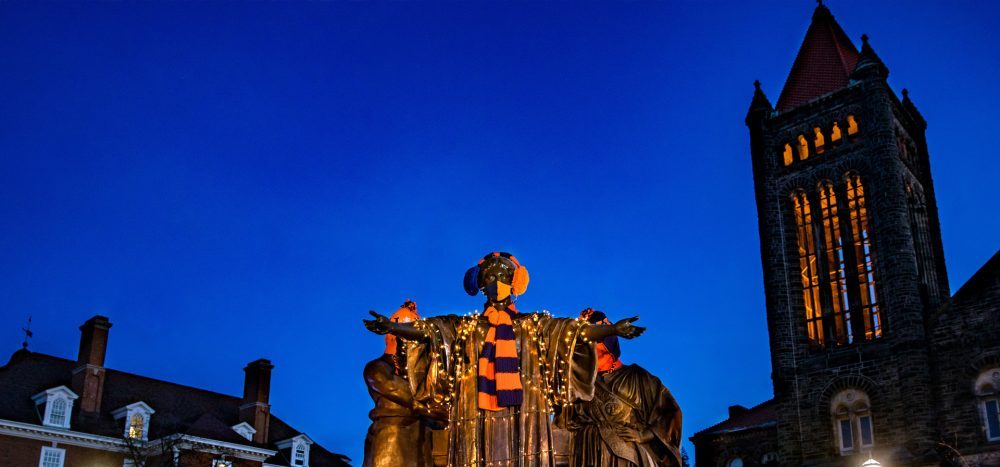Lie groups and Lie algebras were discovered by the Norwegian mathematician Sophus Lie in the second half of the 19th Century. His motivation was to design a Galois Theory for differential equations, which would allow to determined if one could solve a differential equation, as well as to find systematic methods of integration. Soon after, it was realized that Lie groups and algebras play a fundamental role in many other areas of mathematics. Nowadays, they are recognized as a basic tool in mathematics and its applications. This course will provide a solid introduction to the basic of Lie groups and Lie algebras, as well as some applications. Students taking this course are assumed to know abstract algebra and differential geometry at the level of Math 500 – Abstract Algebra I and Math 518 – Differentiable Manifolds.
Lecturer:Rui Loja Fernandes
Email: ruiloja (at) illinois.edu
Office: 346 Illini Hall
Office Hours: Mon and Wed 11:00 AM (or by appointment);
Class meets: MWF 10:00-10:50 AM, 347 Altgeld Hall;
Prerequisites: Math 500 and Math 518, or equivalent.
In this page:
- Announcements
- Syllabus
- Textbooks
- Grading Policy and Exams
- Homework Assignments
- Emergency information for students in Mathematics courses
Announcements:
- I have made available Homework 4. It is due on Friday, December 16.
- You can view the scores of homeworks on-line (please note that you will have to log in).
Syllabus:
- Lie Groups and their Lie algebras: Lie groups, Lie algebras, homomorphisms, subgroups, coverings, 1-connected Lie groups, exponential map, closed subgroups, Lie group-Lie algebra correspondence. Adjoint and coadjoint representations. Lie’s Third Theorem.
- Proper Actions: Proper actions, quotients, principal bundles and homogenous manifolds. Bochner Linearization theorem, slices, tube theorem, orbit spaces, orbit types and stratification, principal and regular orbit types, blowups and desingularization.
- Compact Lie groups and Their Representations: Adjoint action, centralizers, root and root spaces, maximal tori, orbit structure, Weyl group, Stiefel diagram, unitary groups, integration and the Weyl integration formula, Schur’s lemma, characters, G-types, Peter-Weyl Theorem.
- Applications to Symmetries of Differential Equations: jet spaces, prolongation, symmetry groups of differential equations; Lie algebra of symmetries, calculation of symmetry groups.
Textbooks:
- F. Warner, Foundations of Differentiable Manifolds and Lie Groups, GTM 94, Springer-Verlag, Berlin, 1983.
- J.J. Duistermaat and J.A.C. Kolk, Lie groups, Universitext, Springer-Verlag, Berlin, 2000.
- P. Olver, Applications of Lie groups to Differential Equations, 2nd Edition, GTM 107, Springer-Verlag, Berlin, 1993.
Grading Policy
- Homework and Expository Paper: I will assign some homework. Students will also be required to write (in LaTeX) and present a paper. The papers will be due by the last week of classes. Presentations will be in class, during the last week of classes.
Homework Assignments and Sections covered so far:
- Homework #1: list of problems and some solutions.
- Homework #2: list of problems and some solutions.
- Homework #3: list of problems
- Homework #4: list of problems (no solution will be provided)
Note: Solutions to the homework assignements were prepared by the grader Seth Wolbert.
Material covered so far:
- Week 1: Lie groups and Lie algebras; homomorphisms of Lie groups and Lie algebras; Lie subalgabras and Lie subgroups (Warner: pp 82-93)
- Week 2: Initial submanifolds, foliations and the Frobenius Theorem; Lie I: integrating Lie subalgebras to Lie subgroups (Warner: pp 26-29, pp 41-49 and pp 93-98)
- Week 3: Covering spaces, covering groups, 1-connected Lie groups, path space construction. Lie II: integrating Lie algebra homomorphisms to Lie group homomorphisms. Examples: connected abelian Lie groups; Lie groups of small dimension; (Warner: pp 98-101, DK: 1.2,1.12, 1.13)
- Week 4: Exponential map, abstract subgroups versus Lie subgroups, continuous homomorphisms, closed subgroups (Warner: pp 102-112; DK: 1.3, 1.4, 1.10)
- Week 5: Representations of a Lie group and Lie algebra; Adjoint and coadjoint representations of a Lie group and a Lie algebra; Normal Lie subgroups and ideals; center of a Lie algebra and a Lie group (Warner: pp 112-117).
- Week 6: The differential of the exponential map; regular and singular values of exp; multiplication in logarithmic coordinates; CBH series and Dynkin’s formula; Local Lie groups (DK: 1.5-1.7)
- Week 7: Lie III: paths in Lie groups and Lie algebras, homotopy of Lie algebra paths, smooth structure and vanishing of 2nd cohomology (DK: 1.14-1.15)
- Week 8: Lie group actions: stabilizers, orbits, homogeneous spaces, equivariant maps, quotients (Warner: 120-130, DK: 1.11)
- Week 9: Infinitesimal actions: isotropy Lie algebras, flows, Palais Theorem. The Bochner Linearization Theorem. Average, Haar measures and integration on Lie groups. (DK: 1.11, 2.1-2.2; Warner: 151-153)
- Week 10: Proper actions: the Slice Theorem and the Tube Theorem; Orbit space of a proper action: invariant partitions of unity, existence of invariant metrics; Orbit types and local orbit types. (DK: 2.3-2.5)
- Week 11: Regular and principal orbit types; graph of orbit types; resolution of singularities. Mostow-Palais embedding theorem. (DK: 2.6-2.7)
- Week 12: Symmetries of differential equations. Symmetries of algebraic equations; computation of infinitesimal symmetries of algebraic equations; invariant functions; functional dependence; computation of invariants. (Olver 2.1-2.2)
- Week 13: Jets: kth order contact, jet spaces, systems of differential equations, prolongation of actions and symmetries of differential equations, prolongation formula (Olver 2.3)
(PDF files can be viewed using Adobe Acrobat Reader which can be downloaded for free from Adobe Systems for all operating systems.)
Emergency information for students in Mathematics courses
For important emergency information related to fires, tornados or active threats, please look at the following leaflet and emergency instructions.
Last updated December 2, 2016.

